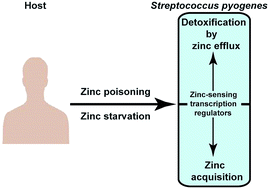当前位置:
X-MOL 学术
›
Metallomics
›
论文详情
Our official English website, www.x-mol.net, welcomes your
feedback! (Note: you will need to create a separate account there.)
Zinc’ing it out: zinc homeostasis mechanisms and their impact on the pathogenesis of human pathogen group A streptococcus
Metallomics ( IF 2.9 ) Pub Date : 2017-10-09 00:00:00 , DOI: 10.1039/c7mt00240h Nishanth Makthal 1, 2, 3, 4, 5 , Muthiah Kumaraswami 1, 2, 3, 4, 5
Metallomics ( IF 2.9 ) Pub Date : 2017-10-09 00:00:00 , DOI: 10.1039/c7mt00240h Nishanth Makthal 1, 2, 3, 4, 5 , Muthiah Kumaraswami 1, 2, 3, 4, 5
Affiliation

|
Group A Streptococccus (GAS) is a major human pathogen that causes significant morbidity and mortality. Zinc is an essential trace element required for GAS growth, however, zinc can be toxic at excess concentrations. The bacterial strategies to maintain zinc sufficiency without incurring zinc toxicity play a crucial role in host–GAS interactions and have a significant impact on GAS pathogenesis. The host deploys nutritional immune mechanisms to retard GAS growth by causing either zinc deprivation or zinc poisoning. However, GAS overcomes the zinc-dependent host defenses and survives in the hostile environment by employing complex adaptive strategies. In this review, we describe the different host immune strategies that employ either zinc limitation or zinc toxicity in different host environments to control GAS infection. We also discuss the molecular mechanisms and machineries used by GAS to evade host nutritional defenses and establish successful infection. Emerging evidence suggests that the metal transporters are major GAS virulence factors as they compete against host nutritional immune mechanisms to acquire or expel metals and promote bacterial survival in the host. Thus, identification of GAS molecules and elucidation of the mechanisms by which GAS combats host-mediated alterations in zinc availability may lead to novel interference strategies targeting GAS metal acquisition systems.
中文翻译:

进行锌分析:锌稳态机制及其对人类病原体A群链球菌发病的影响
A组链球菌(GAS)是导致重大发病和死亡的主要人类病原体。锌是GAS生长所需的必需微量元素,但是,锌在过量时可能有毒。维持锌充足而不引起锌毒性的细菌策略在宿主与GAS的相互作用中起着至关重要的作用,并且对GAS的发病机理具有重要的影响。宿主利用营养免疫机制通过引起锌缺乏或锌中毒来延缓GAS的生长。然而,GAS克服了锌依赖的宿主防御,并通过采用复杂的适应性策略在恶劣的环境中生存。在这篇综述中,我们描述了在不同宿主环境中采用锌限制或锌毒性来控制GAS感染的不同宿主免疫策略。我们还讨论了GAS用来逃避宿主的营养防御并建立成功感染的分子机制和机制。新兴证据表明,金属转运蛋白是主要的GAS毒力因子,因为它们与宿主的营养免疫机制竞争,以获取或排出金属并促进宿主中的细菌存活。因此,GAS分子的鉴定和GAS对抗宿主介导的锌利用率变化的机理的阐明可能会导致针对GAS金属采集系统的新型干扰策略。新兴证据表明,金属转运蛋白是主要的GAS毒力因子,因为它们与宿主的营养免疫机制竞争,以获取或排出金属并促进宿主中的细菌存活。因此,GAS分子的鉴定和GAS对抗宿主介导的锌利用率变化的机理的阐明可能会导致针对GAS金属采集系统的新型干扰策略。新兴证据表明,金属转运蛋白是主要的GAS毒力因子,因为它们与宿主的营养免疫机制竞争,以获取或排出金属并促进宿主中的细菌存活。因此,GAS分子的鉴定和GAS对抗宿主介导的锌利用率变化的机理的阐明可能会导致针对GAS金属采集系统的新型干扰策略。
更新日期:2017-10-18
中文翻译:

进行锌分析:锌稳态机制及其对人类病原体A群链球菌发病的影响
A组链球菌(GAS)是导致重大发病和死亡的主要人类病原体。锌是GAS生长所需的必需微量元素,但是,锌在过量时可能有毒。维持锌充足而不引起锌毒性的细菌策略在宿主与GAS的相互作用中起着至关重要的作用,并且对GAS的发病机理具有重要的影响。宿主利用营养免疫机制通过引起锌缺乏或锌中毒来延缓GAS的生长。然而,GAS克服了锌依赖的宿主防御,并通过采用复杂的适应性策略在恶劣的环境中生存。在这篇综述中,我们描述了在不同宿主环境中采用锌限制或锌毒性来控制GAS感染的不同宿主免疫策略。我们还讨论了GAS用来逃避宿主的营养防御并建立成功感染的分子机制和机制。新兴证据表明,金属转运蛋白是主要的GAS毒力因子,因为它们与宿主的营养免疫机制竞争,以获取或排出金属并促进宿主中的细菌存活。因此,GAS分子的鉴定和GAS对抗宿主介导的锌利用率变化的机理的阐明可能会导致针对GAS金属采集系统的新型干扰策略。新兴证据表明,金属转运蛋白是主要的GAS毒力因子,因为它们与宿主的营养免疫机制竞争,以获取或排出金属并促进宿主中的细菌存活。因此,GAS分子的鉴定和GAS对抗宿主介导的锌利用率变化的机理的阐明可能会导致针对GAS金属采集系统的新型干扰策略。新兴证据表明,金属转运蛋白是主要的GAS毒力因子,因为它们与宿主的营养免疫机制竞争,以获取或排出金属并促进宿主中的细菌存活。因此,GAS分子的鉴定和GAS对抗宿主介导的锌利用率变化的机理的阐明可能会导致针对GAS金属采集系统的新型干扰策略。











































 京公网安备 11010802027423号
京公网安备 11010802027423号